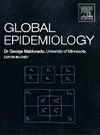Epidemiology of stroke in Pakistan and its provinces, 1990–2021: Findings from the global burden of disease study 2021
引用次数: 0
Abstract
Background
Despite stroke being a leading cause of death in Pakistan, no study has comprehensively analyzed national and regional trends over time. This gap limits understanding of the evolving burden and underlying risk factors.
Methods
We analyzed regional stroke trends in Pakistan from 1990 to 2021 using Global Burden of Disease (GBD) 2021 data. Age-standardized incidence, prevalence, mortality, disability-adjusted life years (DALYs), and 18 modifiable risk factors were analyzed across provinces. Joinpoint regression identified temporal trends through annual percent changes (APCs), and population attributable fractions (PAFs) quantified risk contributions. All estimates incorporated 95 % uncertainty intervals and underwent sensitivity testing to ensure robustness.
Findings
In 2021, stroke was the second leading cause of death in Pakistan, responsible for 99,759 deaths, with an incidence of 153 and a prevalence of 1088 per 100,000 population. Age-standardized rates for incidence, prevalence, mortality, and DALYs declined overall from 1990 to 2021 (ASIR AAPC: −0.15 %), though reductions were modest. Regional trends showed the steepest declines in Islamabad and Punjab, while Balochistan experienced an increase in mortality (ASMR AAPC: +0.03 %) and DALYs (+0.05 %). Sex-specific trends showed greater declines in incidence and mortality among females, while DALY reductions were modest in both sexes, reflecting ongoing disability. High systolic blood pressure was the leading risk factor for stroke mortality (25.2 per 100,000) and DALYs (674.9 per 100,000), followed by household air pollution, ambient particulate matter, and high fasting glucose. These findings reflect the combined influence of cardiometabolic, environmental, and behavioral risks on Pakistan's evolving stroke burden.
Interpretation
Despite modest improvements, stroke remains a major health challenge in Pakistan, with rising long-term disability and stark regional inequalities. Strengthening prevention, equitable access, and post-stroke care is essential to curb the growing burden.

1990-2021年巴基斯坦及其各省中风流行病学:来自2021年全球疾病负担研究的结果
尽管中风是巴基斯坦的主要死亡原因,但没有一项研究全面分析了国家和地区的长期趋势。这一差距限制了对不断变化的负担和潜在风险因素的理解。方法:我们使用全球疾病负担(GBD) 2021数据分析1990年至2021年巴基斯坦区域卒中趋势。对各省的年龄标准化发病率、患病率、死亡率、残疾调整生命年(DALYs)和18个可改变的危险因素进行分析。接合点回归通过年百分比变化(APCs)确定时间趋势,而人口归因分数(PAFs)量化风险贡献。所有的估计都包含95%的不确定区间,并经过敏感性测试以确保稳健性。2021年,中风是巴基斯坦第二大死因,造成99,759人死亡,发病率为153人,患病率为每10万人1088人。从1990年到2021年,年龄标准化的发病率、患病率、死亡率和DALYs总体下降(ASIR AAPC: - 0.15%),尽管下降幅度不大。区域趋势显示,伊斯兰堡和旁遮普的下降幅度最大,而俾路支省的死亡率和伤残调整生命年分别上升了0.03%和0.05%。按性别区分的趋势显示,女性的发病率和死亡率下降幅度较大,而男女伤残津贴年的下降幅度不大,反映出持续的残疾。高收缩压是中风死亡率(25.2 / 10万)和伤残调整生命年(674.9 / 10万)的主要危险因素,其次是家庭空气污染、环境颗粒物和空腹血糖过高。这些发现反映了心脏代谢、环境和行为风险对巴基斯坦不断变化的中风负担的综合影响。尽管有所改善,但中风仍然是巴基斯坦面临的主要健康挑战,长期残疾人数不断上升,地区不平等现象严重。加强预防、公平获取和卒中后护理对于遏制日益加重的负担至关重要。
本文章由计算机程序翻译,如有差异,请以英文原文为准。
求助全文
约1分钟内获得全文
求助全文

 求助内容:
求助内容: 应助结果提醒方式:
应助结果提醒方式:


